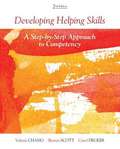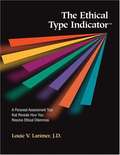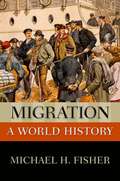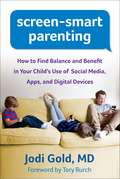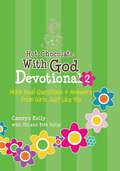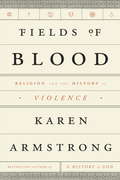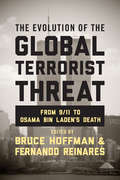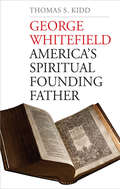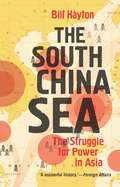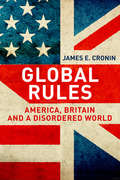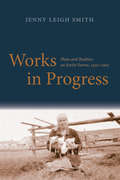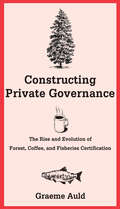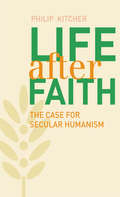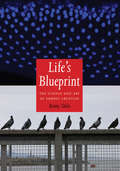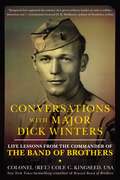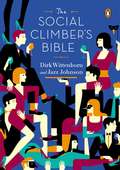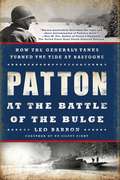- Table View
- List View
Developing Helping Skills: A Step-by-step Approach To Competency
by Valerie Nash Chang Sheryn T. Scott Carol L. DeckerWhether you are preparing for social work, psychology, counseling, marriage and family therapy, pastoral counseling, human services, or a related helping profession, this unique book offers the fundamental knowledge and skills sets you need. The authors' multilayered learning system integrates reading, discussion, observation and visualization, practice, and evaluation. Self-assessment, critical thinking, and practice play a central role in the book's presentation as the text prepares professionals in training for generalist practice with individuals, families, and groups, including entire communities and organizations. You begin by reading the text and completing the homework exercises that follow each new concept. You then view the accompanying DVD (available for purchase) to see how to apply the skills in practice effectively. The text's case-based approach helps you think like a professional with a continuing case that is introduced one section at a time. Finally, role playing in practice interviews and completing evaluation tools allow you to assess progress and determine your personal readiness to apply your skills within actual life settings.
Ethical Type Indicator: Packet Of 5
by Larimer LouieEthical Type Indicator: Packet Of 5 is an assessment that scores your personality revealing your preferences and the extent the other ethical principles influence your decision making. It contains 42 descriptive statements, with each statement measuring your degree of disagreement or agreement.
Go Organic, Level 6
by Saddleback Educational Publishing StaffThemes: Hi-Lo, nonfiction, full-color, differentiated instruction. Teach environmental studies and global warming in the inclusive classroom with these unique informational books. Available in two reading levels with identical front covers, so striving readers do not feel "singled out," each title methodically explains the tough problems faced by our planet plus solutions large and small. Features include: Reading level 3 books are Fountas-Pinnell level O, P, and Q; reading level 6 books are Fountas-Pinnell level W. Scientific terms are defined in context. Identical dramatic four-color covers (back cover band identifies books that are lower level). Teacher's Guides with reproducible activities allow students to work from either text. Glossary defines difficult terms. "Did You Know?" sections contain interesting facts. End-of-book "Facts & Figures" section summarizes critical information. The index takes students directly to topics of interest.
Lunatic: The Rise and Fall of an American Asylum
by Edward GleasonThe Trans-Allegheny Lunatic Asylum, constructed between 1858 and 1881, is the largest hand-cut stone building in the western hemisphere. This haunting gothic structure was the end of the line for West Virginia's insane for 150 years. There are nine acres of wards crowned by a looming 200 foot clock tower. The asylum's massive walls hold terrifying tales of Civil War raids, arson, murder, and suicide.
Migration: A World History
by Michael H. FisherMigration began with our origin as the human species and continues today. Each chapter of world history features distinct types of migration. The earliest migrations spread humans across the globe. Over the centuries, as our cultures, societies, and technologies evolved in different material environments, migrants conflicted, merged, and cohabited with each other, creating, entering, and leaving various city-states, kingdoms, empires, and nations. During the early modern period, migrations reconnected the continents, including through colonization and forced migrations of subject peoples, while political concepts like "citizen" and "alien" developed. In recent history, migrations changed their character as nation-states and transnational unions sought in new ways to control the peoples who migrated across their borders. This volume will explore the process of migration chronologically and also at several levels, from the illuminating example of the migration of a individualcommunity, to larger patterns of the collective movements of major ethnic groups, to the more abstract study of the processes of emigration, migration, and immigration. This book will concentrate on substantial migrations covering long distances and involving large numbers of people. It will intentionally balance evidence from the now diverse people's of the world, for example, by highlighting an exemplary migration for each of the six chapters that highlights different trajectories and by keeping issues of gender and socio-economic class salient wherever appropriate. Further, as a major theme, the volume will consider how technology, the environment, and various polities have historically shaped human migration. Exciting new scholarship in the several fields inherent in this topic make it a particularly valuable and timely project. Each chapter will contain short individual examples, maps, illustrations, and brief quotations from diverse types of primary documents, all integrated with each other and analyzed engagingly in the text.
Screen-Smart Parenting
by Tory Burch Jodi GoldAs a practicing child psychiatrist and mother of three, Jodi Gold has a unique understanding of both the mind-boggling benefits and the serious downsides of technology. Dr. Gold weaves together scientific knowledge and everyday practical advice to help you foster your child's healthy relationship to technology, from birth to the teen years. You'll learn: *How much screen time is too much at different ages. *What your kids and teens are actually doing in all those hours online. *How technology affects social, emotional, and cognitive development. *Which apps and games build smarts and let creativity shine. *How your own media habits influence your children. *What you need to know about privacy concerns, cyberbullying, and other dangers. *Ways to set limits that the whole family can live with.
Hot Chocolate With God Devotional #2
by Jill Kelly Erin Kelly Camryn KellyYOU ARE GOD'S DAUGHTER, LOVED AND CHERISHED AS A PRINCESS OF THE KING. Sisters Camryn and Erin Kelly have teamed up once again to answer your questions about life. They talk about friendship, boys, school, having confidence, gossip, Jesus, social media, money, forgiveness, and so much more! Join the Kelly girls as they share their hearts with you and learn how you can apply Scripture and prayer into everything you do, how to live out God's purpose in your day-to-day life, and how God's never-ending love is for you.
Fields of Blood
by Karen ArmstrongFrom the renowned and bestselling author of A History of God, a sweeping exploration of religion's connection to violence. For the first time in American history, religious self-identification is on the decline. Some have cited a perception that began to grow after September 11: that faith in general is a source of aggression, intolerance and divisiveness--something bad for society. But how accurate is that view? And does it apply equally to all faiths? In these troubled times, we risk basing decisions of real and dangerous consequence on mistaken understandings of the faiths subscribed around us, in our immediate community as well as globally. And so, with her deep learning and sympathetic understanding, Karen Armstrong examines the impulse toward violence in each of the world's great religions. The comparative approach is new: while there have been plenty of books on jihad or the Crusades, this book lays the Christian and the Islamic way of war side by side, along with those of Buddhism, Hinduism, Confucianism, Daoism and Judaism. Each of these faiths arose in agrarian societies with plenty of motivation for violence: landowners had to lord it over peasants and warfare was essential to increase one's landholdings, the only real source of wealth before the great age of trade and commerce. In each context, it fell to the priestly class to legitimize the actions of the state. And so the martial ethos became bound up with the sacred. At the same time, however, their ideologies developed that ran counter to the warrior code: around sages, prophets and mystics. Within each tradition there grew up communities that represented a protest against the injustice and violence endemic to agrarian society. This book explores the symbiosis of these 2 impulses and its development as these confessional faiths came of age. The aggression of secularism has often damaged religion and pushed it into a violent mode. But modernity has also been spectacularly violent, and so Armstrong goes on to show how and in what measure religions, in their relative maturity, came to absorb modern belligerence--and what hope there might be for peace among believers in our time.
The Evolution of the Global Terrorist Threat: From 9/11 to Osama bin Laden's Death
by Bruce Hoffman Fernando ReinaresWorld-renowned experts on terrorism track the evolution of global jihad from the attack on the World Trade Center to the death of Osama bin Laden.
George Whitefield
by Thomas S. KiddIn the years prior to the American Revolution, George Whitefield was the most famous man in the colonies. Thomas Kidd’s fascinating new biography explores the extraordinary career of the most influential figure in the first generation of Anglo-American evangelical Christianity, examining his sometimes troubling stands on the pressing issues of the day, both secular and spiritual, and his relationships with such famous contemporaries as Benjamin Franklin, Jonathan Edwards, and John Wesley. Based on the author’s comprehensive studies of Whitefield’s original sermons, journals, and letters, this excellent history chronicles the phenomenal rise of the trailblazer of the Great Awakening. Whitefield’s leadership role among the new evangelicals of the eighteenth century and his many religious disputes are meticulously covered, as are his major legacies and the permanent marks he left on evangelical Christian faith. It is arguably the most balanced biography to date of a controversial religious leader who, though relatively unknown three hundred years after his birth, was a true giant in his day and remains an important figure in America’s history.
The South China Sea
by Bill HaytonChina’s rise has upset the global balance of power, and the first place to feel the strain is Beijing’s back yard: the South China Sea. For decades tensions have smoldered in the region, but today the threat of a direct confrontation among superpowers grows ever more likely. This important book is the first to make clear sense of the South Sea disputes. Bill Hayton, a journalist with extensive experience in the region, examines the high stakes involved for rival nations that include Vietnam, India, Taiwan, the Philippines, and China, as well as the United States, Russia, and others. Hayton also lays out the daunting obstacles that stand in the way of peaceful resolution. Through lively stories of individuals who have shaped current conflicts#151;businessmen, scientists, shippers, archaeologists, soldiers, diplomats, and more#151;Hayton makes understandable the complex history and contemporary reality of the South China Sea. He underscores its crucial importance as the passageway for half the world’s merchant shipping and one-third of its oil and gas. Whoever controls these waters controls the access between Europe, the Middle East, South Asia, and the Pacific. The author critiques various claims and positions (that China has historic claim to the Sea, for example), overturns conventional wisdoms (such as America’s overblown fears of China’s nationalism and military resurgence), and outlines what the future may hold for this clamorous region of international rivalry.
Cunegonde's Kidnapping
by Benjamin J. KaplanIn a remote village on the Dutch-German border, a young Catholic woman named Cunegonde tries to kidnap a baby to prevent it from being baptized in a Protestant church. When she is arrested, fellow Catholics stage an armed raid to free her from detention. These dramatic events of 1762 triggered a cycle of violence, starting a kind of religious war in the village and its surrounding region. Contradicting our current understanding, this war erupted at the height of the Age of Enlightenment, famous for its religious toleration. Cunegonde’s Kidnapping tells in vivid detail the story of this hitherto unknown conflict. Drawing characters, scenes, and dialogue straight from a body of exceptional primary sources, it is the first microhistorical study of religious conflict and toleration in early modern Europe. In it, Benjamin J. Kaplan explores the dilemmas of interfaith marriage and the special character of religious life in a borderland, where religious dissenters enjoy unique freedoms. He also challenges assumptions about the impact of Enlightenment thought and suggests that, on a popular level, some parts of eighteenth-century Europe may not have witnessed a #147;rise of toleration. ”
Global Rules
by Prof. James E. CroninThe Second World War created and the Cold War sustained a #147;special relationship” between America and Britain, and the terms on which that decades-long conflict ended would become the foundation of a new world order. In this penetrating analysis, a new history of recent global politics, author James Cronin explores the dramatic reconfiguring of western foreign policy that was necessitated by the interlinked crises of the 1970s and the resulting global shift toward open markets, a movement that was eagerly embraced and encouraged by the U. S. /U. K. partnership. Cronin’s bold revisionist argument questions long-perceived views of post#150;World War II America and its position in the world, especially after Vietnam. The author details the challenges the economic transition of the 1970s and 1980s engendered as the United States and Great Britain together actively pursued their shared ideal of an international assemblage of market-based democratic states. Cronin also addresses the crises that would sorely test the system in subsequent decades, from human rights violations and genocide in the Balkans and Africa to 9/11 and militant Islamism in the Middle East to the #147;Great Recession” of 2008.
Works in Progress
by Jenny Leigh SmithThis book is the first to investigate the gap between the plans and the reality of the Soviet Union’s mid-twentieth-century project to industrialize and modernize its agricultural system. Historians agree that the project failed badly: agriculture was inefficient, unpredictable, and environmentally devastating for the entire Soviet period. Yet assigning the blame exclusively to Soviet planners would be off the mark. The real story is much more complicated and interesting, Jenny Leigh Smith reveals in this deeply researched book. Using case studies from five Soviet regions, she acknowledges hubris and shortsightedness where it occurred but also gives fair consideration to the difficulties encountered and the successes#151;however modest#151;that were achieved.
Constructing Private Governance
by Graeme AuldRecent decades have witnessed the rise of social and environmental certification programs that are intended to promote responsible business practices. Consumers now encounter organic or fair-trade labels on a variety of products, implying such desirable benefits as improved environmental conditions or more equitable market transactions. But what do we know about the origins and development of the organizations behind these labels? This book examines forest, coffee, and fishery certification programs to reveal how the early decisions of programs on governance and standards affect the path along which individual programs evolve and the variety and number of programs across sectors.
Life After Faith
by Mr Philip KitcherAlthough there is no shortage of recent books arguing against religion, few offer a positive alternative#151;how anyone might live a fulfilling life without the support of religious beliefs. This enlightening book fills the gap. Philip Kitcher constructs an original and persuasive secular perspective, one that answers human needs, recognizes the objectivity of values, and provides for the universal desire for meaningfulness. Kitcher thoughtfully and sensitively considers how secularism can respond to the worries and challenges that all people confront, including the issue of mortality. He investigates how secular lives compare with those of people who adopt religious doctrines as literal truth, as well as those who embrace less literalistic versions of religion. Whereas religious belief has been important in past times, Kitcher concludes that evolution away from religion is now essential. He envisions the successors to religious life, when the senses of identity and community traditionally fostered by religion will instead draw on a broader range of cultural items#151;those provided by poets, filmmakers, musicians, artists, scientists, and others. With clarity and deep insight, Kitcher reveals the power of secular humanism to encourage fulfilling human lives built on ethical truth.
Life's Blueprint
by Benny ShiloIn the span of just three decades, scientific understanding of the formation of embryos has undergone a major revolution. The implications of these new research findings have an immediate bearing on human health and future therapies, yet most nonscientists remain quite unaware of the exciting news. In this engaging book, a distinguished geneticist offers a clear, jargon-free overview of the field of developmental biology. Benny Shilo transforms complicated scientific paradigms into understandable ideas, employing an array of photographic images to demonstrate analogies between the cells of an embryo and human society. Shilo's innovative approach highlights important concepts in a way that will be intuitive and resonant with readers' own experiences. The author explains what is now known about the mechanisms of embryonic development and the commanding role of genes. For each paradigm under discussion, he provides both a scientific image and a photograph he has taken in the human world. These pairs of images imply powerful metaphors, such as the similarities between communication among cells and among human beings, or between rules embedded in the genome and laws that govern human society. The book concludes with a glimpse of promising future possibilities, including the generation of tissues and organs for use as "spare parts. "
Conversations with Major Dick Winters
by Cole C. KingseedOn the hellish battlefields of World War II Europe, Major Dick Winters led his Easy Company--the now-legendary Band of Brothers--from the confusion and chaos of the D-Day invasion to the final capture of Hitler's Eagle's Nest. But Winters's story didn't end there. It was only the beginning. He was a quiet, reluctant hero whose modesty and strength drew the admiration of not only his men, but millions worldwide. Now comes the story of Dick Winters in his last years as witnessed and experienced by his good friend, Cole C. Kingseed. Kingseed shares the formative experiences that made Winters such an effective leader. He addresses Winters's experiences and leadership during the war, his intense, unbreakable devotion to his men, his search for peace both without and within after the war, and how fame forced him to make adjustments to an international audience of well-wishers and admirers, even as he attempted to leave a lasting legacy before joining his fallen comrades. Following Winters's death on January 2, 2011, the outpouring of grief and adulation for one of this nation's preeminent leaders of character, courage, and competence shows just how much of an impact Dick Winters left on the world. This is a story of leadership, fame, and friendship, and the journey of one man's struggle to find the peace that he promised himself if he survived World War II.
The Social Climber's Bible
by Dirk Wittenborn Jazz JohnsonWelcome fledging Social Climbers! Allow us to show you the way. Birds do it, bees do it, even educated fleas do it, so what's the big deal? You shouldn't be punished for wanting to improve your lot in life! This is America, after all. Johnson & Johnson heiress Jazz Johnson is a lifelong insider in that rarefied world that fans of both Downton Abbey and Gossip Girl dream about. Raconteur Dirk Wittenborn is old enough to remember when sex was safe and cocaine wasn't addictive. In short, Jazz belongs to some of the most exclusive clubs in the world, whereas Dirk has been kicked out of them. Who better to guide you? In the grand tradition of True Prep and The Hipster Handbook, The Social Climber's Bible will teach you everything you need to know to become a pro Mountaineer: The Art of Social Climbing at gallery openings, cocktail parties, and funerals Social Climbing as a family How to handle sex, dating, marriage, and love Your social climbing IQ and how to improve it How to spot a Big Fish, Whale, Turtle or Unicorn, and what they can do for you
Patton at the Battle of the Bulge
by Leo BarronDecember 1944. For the besieged American defenders of Bastogne, time was running out....Hitler's forces had pressed in on the small Belgian town in a desperate offensive designed to push back the Allies, starting the Battle of the Bulge. So far the U.S. soldiers had managed to repel waves of attackers and even a panzer onslaught. But as their ammunition dwindled, the weary paratroopers of the 101st Airborne could only hope for a miracle--a miracle in the form of General George S. Patton and his Third Army.More than a hundred miles away, Patton, ordered to race his men to Bastogne, was already putting in motion the most crucial charge of his career. Tapped to spearhead his counterstrike against the Wehrmacht was the 4th Armored Division, a bloodied but experienced unit that had fought and slogged its way across France. But blazing a trail into Belgium meant going up against some of the best infantry and tank units in the German Army. Failure to reach Bastogne in time could result in the overrunning of the 101st--a catastrophic defeat that could turn the tide of the war and secure victory for the Nazis.In Patton at the Battle of the Bulge, Army veteran and historian Leo Barron explores one of the most famous yet little told clashes of the war, a vitally important chapter in one of history's most legendary battles.
The Tale of Dan De Lion
by Thomas M. DischDan De Lion, a weed in the garden of an autocratic rose fancier, truimphs over the threat of extinction in this fable of the ordinary man confronting power and ruthlessness. In the tradition of Lewis Carroll and Edward Gorey, Thomas M. Disch characterizes his rakish dandelions and pampered roses with a combination of humor and philosophical insight. Wry illustrations by Rhonda McClun bring the snooty roses and "lower-dass" dandelions to full flower.
Old Books, New Technologies
by David MckitterickAs we rely increasingly on digital resources, and libraries discard large parts of their older collections, what is our responsibility to preserve 'old books' for the future? David McKitterick's lively and wide-ranging study explores how old books have been represented and interpreted from the eighteenth century to the present day. Conservation of these texts has taken many forms, from early methods of counterfeiting, imitation and rebinding to modern practices of microfilming, digitisation and photography. Using a comprehensive range of examples, McKitterick reveals these practices and their effects to address wider questions surrounding the value of printed books, both in terms of their content and their status as historical objects. Creating a link between historical approaches and the technologies of the future, this book furthers our understanding of old books and their significance in a world of emerging digital technology.
Applications of Group Theory to Atoms, Molecules, and Solids
by Thomas Wolfram nas Ell altio luThe majority of all knowledge concerning atoms, molecules, and solids has been derived from applications of group theory. Taking a unique, applications-oriented approach, this book gives readers the tools needed to analyze any atomic, molecular, or crystalline solid system. Using a clearly defined, eight-step program, this book helps readers to understand the power of group theory, what information can be obtained from it, and how to obtain it. The book takes in modern topics, such as graphene, carbon nanotubes and isotopic frequencies of molecules, as well as more traditional subjects: the vibrational and electronic states of molecules and solids, crystal field and ligand field theory, transition metal complexes, space groups, time reversal symmetry, and magnetic groups. With over 100 end-of-chapter exercises, this book is invaluable for graduate students and researchers in physics, chemistry, electrical engineering and materials science.
The Sainte-Chapelle and the Construction of Sacral Monarchy
by Meredith CohenThis book offers a novel perspective on one of the most important monuments of French Gothic architecture, the Sainte-Chapelle, constructed in Paris by King Louis IX of France between 1239 and 1248 especially to hold and to celebrate Christ's Crown of Thorns. Meredith Cohen argues that the chapel's architecture, decoration, and use conveyed the notion of sacral kingship to its audience in Paris and in greater Europe, thereby implicitly elevating the French king to the level of suzerain, and establishing an early visual precedent for the political theories of royal sovereignty and French absolutism. By setting the chapel within its broader urban and royal contexts, this book offers new insight into royal representation and the rise of Paris as a political and cultural capital in the thirteenth century.
Magnetoconvection
by N. O. Weiss M. R. E. ProctorThe last thirty years have seen great leaps forward in the subject of magnetoconvection. Computational techniques can now explain exotic nonlinear behaviour, transition to chaos and the formation of structures that can be observed on the surface of the Sun. Here, two leading experts present the current state of knowledge of the subject. They provide a mathematical and numerical treatment of the interactions between electrically conducting fluids and magnetic fields that lead to the complex structures and rich behaviour observed on the Sun and other stars, as well as in the interiors of planets like the Earth. The authors' combined analytical and computational approach provides a model for the study of a wide range of related problems. The discussion includes bifurcation theory, chaotic behaviour, pattern formation in two and three dimensions, and applications to geomagnetism and to the properties of sunspots and other features at the solar surface.
